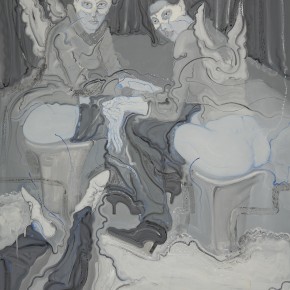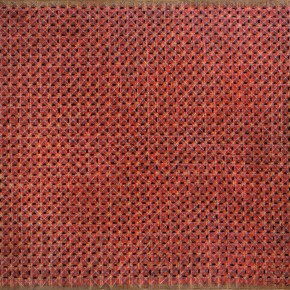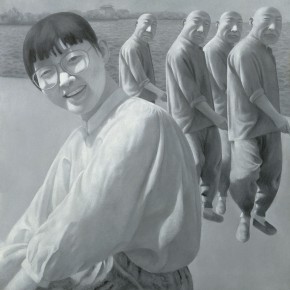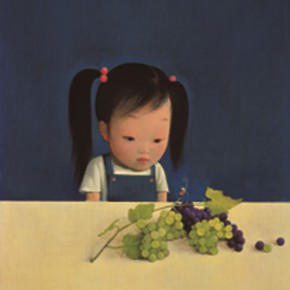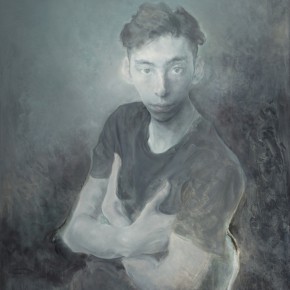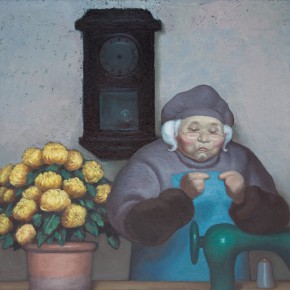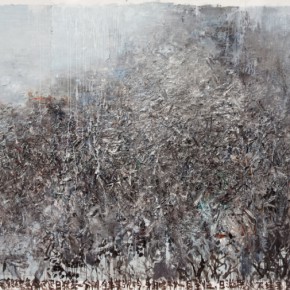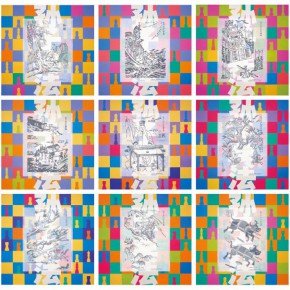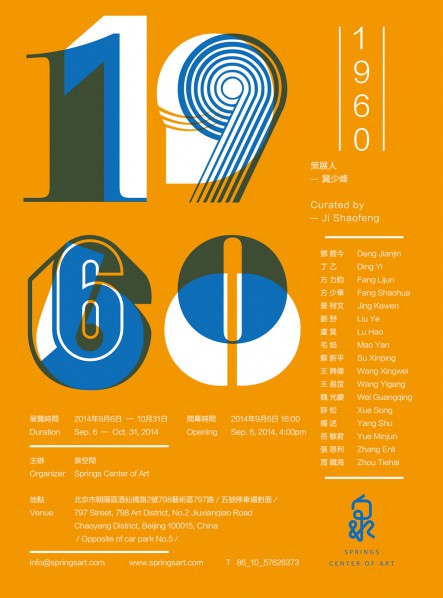
JI Shao-Feng
Art Critic, Curator, Vice Director of Hubei Museum of Art
Daniel Bell, in his The Cultural Contradiction of Capitalism, argued political and cultural radicalism prevailed on a global scale in the 1960s. ZHAN Ming-Xin argues that the 60s left long impact in a short period of time in the 20th century has drawn to an end with the Chilean coup d’état on Sept. 11, 1973. Global political unrest followed the events of the Vietnam War, the Che Guevara phenomena, Paris in May 1968, Autunnon Caldo in Italy and the Cultural Revolution in China. At the same time, US withdrew from Vietnam and the Cultural Revolution in China was ceased. Social structures have been shredded under turmoil. People born in the 60s were confronted with a conclusion of a chaotic epoch and a beginning of a new era. Their life experiences and artistic styles are evidently influenced under events in the 60s. They have become signs and knowledge systems of this period. Because of their capabilities of adhering to spiritual beliefs empowered by their cultural positions, even with vanished political idols and rising of capitalism, they have become the primary engine stimulating the development of contemporary art.
People from the 60s are distinctive and born in a transitional epoch that offered an observatory position to them. They merely are aware of the repression and pessimism in the 50s, nor live recklessly like people born in the 70s. Therefore they are nothing but extraordinary. We have witnessed that this generation, with heroic minds, is passionate about idealism and appreciates honesty and sincerity. Cultural renaissance and their compassion towards individuals are embodied in their personal expressions as well as in their art. They have provided us with a new perspective to understand their vigor, dreams, responsibilities and missions. They are infused with spirits of the 70s then diffuse to the society with dreams and passion. Their artworks represent the mind, spirit and soul of this generation; they have encapsulated artists’ respect for cultural position, ideals and morals.
A series of research presented by Springs Art is established on the above cultural context. The research will address artists’ macro context on international and domestic scales, as well as their psychological appeal. It also examines the complicated relationships among styles, forms, mode of studying, mode of narrative, collectivism versus individualism, a country, a society, an individual, official versus unofficial, in versus out of a system, above versus under ground. The series of exhibitions attempts to reveal the artistic liberty behind the narratives addressing revolutions and turmoil.
CULTURAL MEMORIES AND CULTURAL REPRESENTATIONS FROM SOCIALISM
“Art is subordinated to politics” is the highlight of Mao Zedong’s Speech at the Yan’an Forum on Literature and Art, which stressed the inevitable relationship between the two. During Cultural Revolution, this much distorted and exaggerated concept defined the subject matter, style and presentation of art; the subject matter must address the three classes of people working in manufacturing, agriculture and military (San Jie He); the creative process must represent nobility, grandeur and wholeness (San Tu Chu); the canvas must look red, bright and shiny (Hong Guang Liang). These assigned approaches were essential to the artists that have now became the major force in the contemporary Chinese art scene. In the special edition for the 70s in Today magazine, poet Bei Dao and writer Li Duo recognized the value contribution made by this generation to today’s Chinese society. They wrote:
The generation we discuss here is specific; these people spent their adolescence and youth in the 70s. They grew up in special historical surroundings which contribute to their distinctiveness. It is this group of people that has played significant and unique roles in China after the Cultural Revolution.
In the fine art circle, there are a group of artists have represented and reflected socialism memories and cultural experiences in their pictorial narratives, such as DENG Jian-jin, DING Yi, FANG Li-Jun, FANG Shao-Hua, JING Ke-Wen, LIU Ye, WU Hao, MAO Yan, SU Xin-Ping, WANG Xing-Wei, WANG Yi-Gang, WEI Guang-Qing, XUE Song, YANG Shu, YUE Min-Jun, ZHANG En-Li, Zhou Tie-Hai, only to name a few. The cultural phenomenon about these artists is sourced from their trajectories in art, which are accompanied by the development of the contemporary Chinese art. Each of them has adapted a differentiated visual style and various personal narratives, so they reflect the progress of contemporary Chinese art. Their lives, experiences and visual stories are evidently bounded with social, economic and cultural development. Examining the changes behind their works would allow us to investigate the effects brought by the transformation of society in the aspects of lifestyles and ideologies.
Looking into the paths of these artists, we found that Cultural Revolution and Deng Xiaoping’s opening up policies are central to their works. The representations of historical reflection, cultural criticism, socialism lifestyle and cultural memories evoke a strong repercussion of a generation. It is commendable that the spiritual evocation, cultural reconstruction and the investigations of psychologies of people during urbanization in these works represent artists’ compassion towards history and culture. These artists purposefully constructed their own visual systems behind the canvas. Besides the succession of traditions, they criticize and expand these conventions. It should be acknowledged that these artists have expressed their individuality successfully as well as compassionate articulation of social and artistic lives.
CHARACTERISTICS IN THEIR VISUAL NARRATIVES
1. Symbolization of Cynical Realism
FANG Li-Jun and YUE Min-Jun are leading figures of this genre. Their artworks are representations of the boredom, superficiality, depression and anxiety of a generation who suffered from psychological confusion when China was undergoing the transition from planned economy to market economy. Fang and Yue have distinctive and subversive personalities, together with their psychological experiences, undoubtedly have fulfilled dreams of the many in their generation. The independent, unconstrained spirits and their pursuit of an unrestrained lifestyle certainly would have inspired many. The Gutian Conference by Yue is a key piece in his Scenarios series. It has represented an event that was more important politically than artistically. By removing all figures, the work has presented an intriguing, isolated and eternal void that evoking endless pondering.
2. The Invasion and Prevalence of Pop Art
WEI Guang-Qing, the Chinese Pop Art leading artist, examines contemporary issues with history in his works conveying a subtle meaning making process of how visual culture transcends classical and contemporary social practice in a multicultural society. His subject matters and style are logically interconnected. His works rise above history, culture and cultural boundaries because of his profound imagination and observation of crucial cultural phenomenon. His visual devices suggest implications that are psychological, emotional and cultural. Meanwhile, his thoughtful mind is embedded in the writings flowed from his heart. Individual anxious experiences and daily hassles address cultural representations that are stimulated by social structural changes.
FANG Shao-Hua has created a new system of semiotics with his visual devices; classical images were re-contextualized after being separated from the original contexts. In this process of borrowing and mimicking, the artist enjoys pleasurable visual experiences and presents questions toward consumerism found in our times. He has present his thought processes on society and his creative life in an extremely personal approach. His personal belief is embodied in these artworks which are comprised of the deconstruction of classical divinity, the winning over of anxious pondering to social criticism and the re-contextualized Expressionism in an urban visual surroundings. His recent works became more conceptual and abstract, which evokes delightful and exciting experiences in the psychologies of beholders.
Artworks by XUE Song are prominently Pop Art. Reconstruction, juxtaposition and fragmentation of memories from the past filled his canvas that conveys the fragmented feature in history. Sentiments about traditions and desire towards contemporary culture are evidently represented in his works by which they also encapsulate the observatory apprehension of the ever-changing global politics. Crossing of time and space, colliding among cultures, memories of the past, visual memories and narrative of socialism also empowered his creativity.
3. Logics of Abstract Narrative
In decades, DING Yi has never tired of representing the cross that not only summarizes his paths in art but also become his signature visual device. As a visual sign, the cross is highly valuable in contemporary Chinese art. Our lives have been recorded in his organized, rational, singular canvas by which an international perspective and spirits of this era are emerged. Paintings have resurrected into forms and mentalities of an era on a global scale.
WANG Yi-Gang expresses his explosive energy by layering, covering and scratching paint, and mixing lines with colors in forming his courageous spirit of transcendence. On canvas, he constructs representations of energy and dynamism that are synchronized in the viewing experience. Beholders would have been able to sense represented escapism from regulated systems, as well as the liberations behind his canvas and human constraints.
4. Passion in Expressionism
Eroticism, taboos, violence, desire, sexual consciousness, anxiety and restlessness during adolescence are significant to DENG Jian-Jin’s visual narrative. His passionate brushstrokes depict primitive desires and passions. He seems to present an analogy explaining the beautiful but dangerous nature of sexual desires.
MAO Yan is born with enthusiasm and gifts associated with art. His canvas is charged with charming shades of grey, obscure and melancholic figures and dimming background. Together they have presented an unforgettable visual experience filled with complexity, anxiety and purity that are surrounded by intricate and meaningful imagery. His living experiences are embodied in his portraits that also serve as self-portraits; his works represent his attitude toward contemporary society and life as an artist.
SU Xin-ping has been striving to meditate on relationships among human beings, natural environment and our society. His seemingly routine painting practice attempts to covey rational pondering in his soul. He paints from his sensations that feed his pleasure and temptation to the future.
JING Ke-Wen depicts the lifestyle, environment and memories of living under a planned economy. These depictions project memories of people from 60s and 70s about personal space and public space; they have visualized the physical and imaginary legacies of the revolutionary epoch. On the other hand, they are the political narrative that could inspire investigations on public discourse formed by combining historical narrative and personal experiences.
Among playful contemplation between a compassionate macro narrative and a relaxed micro narrative, LU Hao directs his attention on living environment and conditions. Shifting from imageries of Old Beijing, Lu has started painting portraits revealing the power of posing continuous inquiry and glory of ideology. What has contributed to our society today? Through his self-portraits, Lu has been interrogating contemporary society and his creative life. He is isolated because of his thoughts and his isolation allowed him to only convey his passion on his canvas. .
Works by YANG Shu has captured the essence of Abstract Expressionism, also has a tendency of a failed painting. His conceptual, rustic handling of paint evokes beholders’ surging of passion and unleashing of desires. Embedded in simplicity, his canvas conveys a sense juxtaposing richness, power, rustic and sophistication, as well as rationality and charm.
5. Parody and Psychologies of a Gamer
LIU Ye painting is about parodies of classic subject matters. Loneliness, confusion and grief are featured in his works which also represent a sense of isolation from the reality. This sense is the defining part of the characteristic of his visual language.
The imagery world built by WANG Xing-Wei is witty and humorous. His continuous teasing of art history has condensed his creative concepts. His artworks defend the integrity of painting as an art form which serves as an introspection of our cultural patterns built from fragments, details and meaningless moments. It may seem to be unconventional and casual, but he is effortlessly capable of capturing excitements and articulating his visual devices.
The capricious style of ZHOU Tie-Hai’s artworks has left an irreplaceable mark in contemporary Chinese art. He swings among graffiti, video, digital images and oil paintings showcasing his sensitive, witty and unusual perspective. His capabilities in adapting all forms of art enabled intricate expressions towards art and life; the most important aspect of practicing art is to reveal the relationships among a city, a country and a society.
6. Isolation from Daily Hassles and Unfamiliar Visual Experiences
ZHANG En-Li never stays the same stylistically. Despite his switches from portraits to still life, from enthusiastic to silent, he has been able to juxtapose the inner Zen with rustic and expressive handling of paint. He has also attempt to drawing in a space, incorporated an interior space in a painting. Zhang’s various approaches in art filled his creative world with richness and diverse meanings.
?REFLECTING ON HISTORY AND CONNECTING TO THE PRESENT
It could be argued that these artists have demonstrated their values in practicing criticisms in various forms in the 80s, then, we could also argue that they have been pursuing individualities in their art since the 90s. This group includes YUE Min-Jun, FANG Shao-Hua, WEI Guang-Qing, XUE Song, JING Ke-Wen, WANG Xing-Wei and ZHOU Tie-Hai.
After the above discussions on the features of visual narratives of these artists, we could find a responsive argument by CAI,
“A modern nation is primarily a political nation that is inseparable from culture. The key proposition is about constructing corresponding myths addressing the history of the modern nation (2010, p.19).”
However, we can only understand their individual visual narrative fully in the social, political, economic and cultural context. As Deleuze commented on Kafka that literary creation is a combination of discourse and???? desire reaching beyond the sum of legal, national and social structure, meanwhile, discourse is about history, politics and the society (2007, p.93).
Therefore, politics on a national level has offered the 60s generation a thorough narrative to examine the world with insights. Their works also pushed us to confront with the symbiotic relationship between art and politics.
Entering the second decade of the new century, there will be more social conflicts and inequalities. Peace, rationality and order would be key indicators assessing the maturity of societal development. The vitality of artists is found in truth which is also the character of art. Artists are sensitive to social changes, live in the society at the same time. The extent of convergence of the multi-facets in art and social practice is unseen. The rapid progress of the society with more open policies has posed challenges to evaluate contemporary art accurately. We have all merged in the booming process without acknowledgement. These artists are pioneers who live in the narrative of contemporary art a head of everyone else.
An existed narrative of history never exists in arts, because of the blending of politics, styles and capitals.
This exhibition is only a starting point to address the issues above. It is expected to continue our explorations into installations, sculptures, images, performance works, etc.
Springs Center of Art aims to invest continuously in this field, to establish a platform of exchange of thoughts. The variety of visual languages by the participating artists has proven the vitality, acceptance and openness of a multifaceted society. A space for sharing, participating and interpretation is the result of every artist’s abundant experiences in personal and visual world.
The investigation of artistic phenomenon of 1960s not only serves as guidance to the gallery, more importantly, it represents a form of consciousness of a generation and a long-term research focus.
About the exhibition
Curator: Ji Shaofeng
Artists: Deng Jianjin, Ding Yi, Fang Lijun, Fang Shaohua, Jing Kewen, Liu Ye, Lu Hao, Mao Yan, Su Xinping, Wang Xingwei, Wang Yigang, Wei Guangqing, Xue Song, Yang Shu, Yue Minjun, Zhang Enli, Zhou Tiehai
Duration: Sep.6 – Oct.31,2014
Opening: Sep.6,2014, 4:00pm
Organizer: Springs Center of Art
Courtesyof the artists and Springs Center of Art, for further information please visit www.springsart.com.



